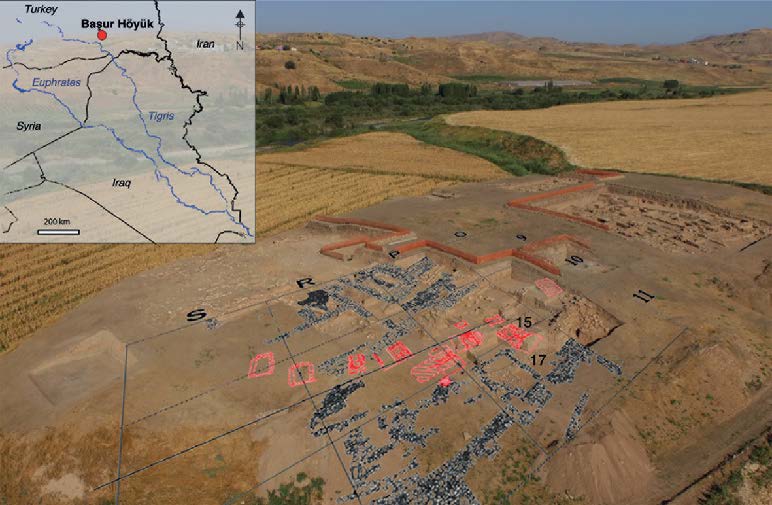Radical ‘royals’? Burial practices at Başur Höyük and the emergence of early states in Mesopotamia, by Hasset and Sağlamtimur, Antiquity (2018) 92:640-654.
Interesting excerpts:
The discovery of sacrificial burials attending a ‘royal’ burial in a cist tomb at Early Bronze Age Arslantepe in Anatolia (Frangipane 2006; Erdal 2012) has dramatically broadened the known range of social responses to the political upheaval of the early third millennium BC. Following the longstanding interpretation of human sacrifice at the Royal Cemetery of Ur just a few hundred years later (Woolley 1934), this raises new questions about the role of human sacrifice in processes of early state formation (Sürenhagen 2002; Croucher 2012). Power over the physical bodies of a population to the point of death has been associated with the hierarchical social structures that accompanied early state-formation processes across the globe (Watts et al. 2016). There is, however, considerable variation in the practice. Sacrifice can be employed variously to achieve spiritual, ritual, political, martial or even economic ends (see Bremmer 2007; Turchin 2016), and the role of human sacrifice in ancient Near Eastern burial practices remains unclear (Porter & Schwartz 2012).

Wengrow draws an interesting distinction between “sacrificial” and “archival” ritual economies, using metal finds from the much wider context of the Eurasian Bronze Age (Wengrow 2011: 137). For Wengrow, the ‘sacrificial’ deposit of metal work, particularly in burial contexts, indicates a system of metal exchange that is most frequently found on the edges of more complex, centrally administrated urban exchange systems. Metalwork serves here to consolidate and display personal wealth rather than as a standardised commodity for equitable exchange. Wilkinson has highlighted the role of shifting economic modes in marking social change, observing such a transition in ritual-economic systems in the Early Bronze Age Trans-Caucasian sphere of influence that stretched from Anatolia to Iran (Wilkinson 2014). The bronze objects buried at Başur Höyük fall into a pattern of ritual deposits that clearly mark Early Bronze Age funerary rituals as locations for the communication of wealth and status (Săglamtimur & Massimino 2015). The importance of that display is not diminished by the presence of administrative artefacts such as the cylinder seals and ceramics marked with seal impressions that were also found inside the cist tomb. The material culture of the Early Bronze Age cemetery at Başur Höyük demonstrates connections to the Anatolian world, with clear Trans-Caucasian links similar to those found along the Euphrates, and also to the southern, urban networks of the Mesopotamian core.
The utility of such sacrificial gestures waned as other means of social control and power display were brought to bear by an administrated, ‘archival’ economy that did not require the sacrifice of its human subjects.(…) In the vacuum of political centralisation that followed the withdrawal of Uruk material culture in the Mesopotamian sphere, we see precisely the instability among smaller polities that would be expected to underlie the introduction of human sacrifice. In the vast administrative state systems that rose up in southern Mesopotamia in the next millennium, it disappears again from the archaeological record and it is not unreasonable to see in this pattern an implication for the value and economy of human life during the formation of early states.

Given the potential Anatolian names in Armi inscriptions (ca. 2500-2300 BC), this crucial period of political upheaval after the fall of Uruk-period Mesopotamian interregional networks and before the rise of new state system, i.e. in the early third millennium BC, is probably to be identified with the arrival of Anatolian speakers from the west.
Similar to the Early Indo-Aryan elites ruling over Hurrian-speaking Mitanni, it is possible that some Anatolian-speaking groups imposed their rule as elites (and thus their language) after this period of instability – at least in certain regions, as is obvious from the multilingualism and multiethnic situation found in the Old Assyrian tablets of Kaneš.
Related
- About Scepters, Horses, and War: on Khvalynsk migrants in the Caucasus and the Danube
- On the Maykop – Upper Mesopotamia cultural province, distinct from the steppe
- Steppe and Caucasus Eneolithic: the new keystones of the EHG-CHG-ANE ancestry in steppe groups
- The Caucasus a genetic and cultural barrier; Yamna dominated by R1b-M269; Yamna settlers in Hungary cluster with Yamna
- Consequences of Damgaard et al. 2018 (I): EHG ancestry in Maykop samples, and the potential Anatolian expansion routes
- No large-scale steppe migration into Anatolia; early Yamna migrations and MLBA brought LPIE dialects in Asia
- Proto-Indo-European homeland south of the Caucasus?
- On the potential origin of Caucasus hunter-gatherer ancestry in Eneolithic steppe cultures
- Consequences of O&M 2018 (II): The unsolved nature of Suvorovo-Novodanilovka chiefs, and the route of Proto-Anatolian expansion
- North Pontic steppe Eneolithic cultures, and an alternative Indo-Slavonic model